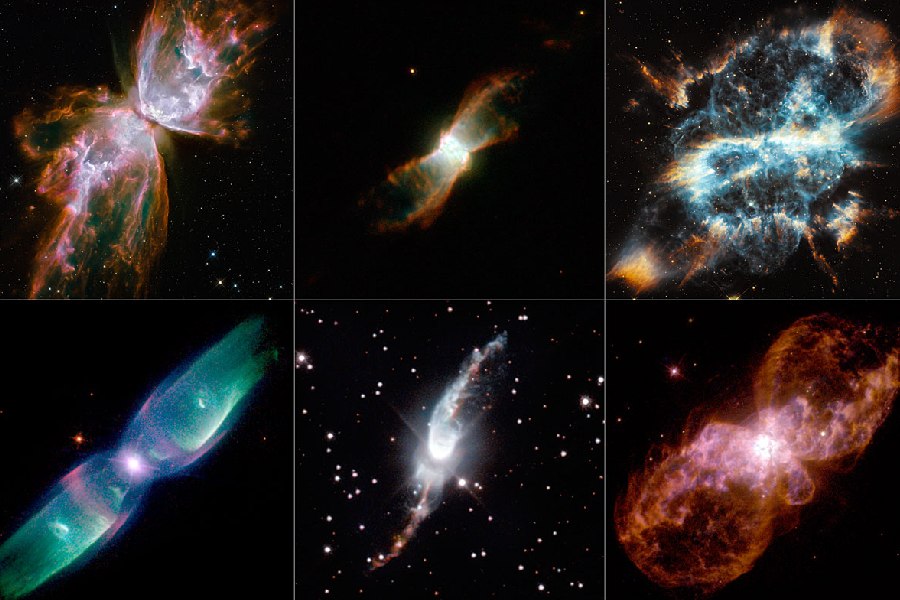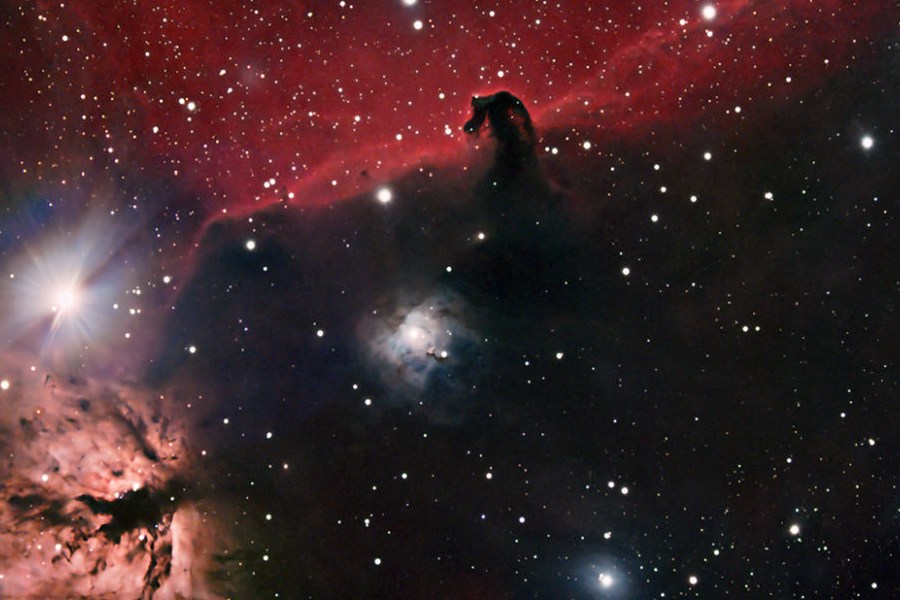If you look closely at the night sky, you might notice a few cloudy blobs glowing or shining among the stars. These are nebulae – large clouds of gas and dust floating in space. Nebulae light up when new stars are born inside them, making stellar nurseries that come in all different shapes, sizes, and types. Stay with us as we explore the list of nebulae, from the remnants of explored stars called supernova remnants to nebulae created when old stars blow off gas at the end of their life.
There are glowing red emission nebulae powered by heat, reflection nebulae that shine by bouncing light off nearby stars, and dark nebulae that block background light to seem like black clouds.

Exploring the List of Nebulae
Observed through telescopes, nebulae appear as glowing clouds of gas and dust floating among the stars.
These include emission nebulae that shine from being heated by close hot stars, reflection nebulae that glisten by scattering nearby starlight, and planetary nebulae – which are actually glowing shells of stellar material blown off aging stars.
Nebulae also take darker forms, like dense dust clouds that dim background starlight or supernova remnants left as expanding, tattered debris.
This debris comes after the exploded death of massive stars. And protoplanetary nebulae represent rotating disks of particles around young protostars where new solar systems take shape.
Cataloged by astronomers photographed by space telescopes like Hubble, nebulae allow us to visually experience the stellar cycles of death and rebirth occurring across the cosmos on inconceivable scales. Their ethereal beauty is both awesome and enlightening.
Planetary Nebulae
Planetary nebulae are glowing shells of gas and plasma that have been ejected from aging red giant stars late in their life cycles. As these stars run out of hydrogen fuel in their cores, they shed their outer layers, creating the nebulae’s illuminated structures.
Some key traits of planetary nebulae are their spherical or ellipsoidal shapes, emission spectra, and luminosities on the order of thousands of solar luminosities.
Famous examples include the Helix Nebula, with its eye-catching helical structure, and the Ring Nebula, with its simple circular shape. The Cat’s Eye Nebula has complex, layered shells that were ejected at different times.
Planetary nebulae illuminate the interstellar medium around them and cycle matter back into space as their parent stars continue to evolve.
Examples of planetary nebulae
Central stars
Central stars are the remnants of red giants that have lost their outer layers. This exposes the hot, dense cores that provide the energy to ionize the surrounding gas clouds and make planetary nebulae glow vibrantly.
Central stars are very hot, with surface temperatures from 30,000-200,000 degrees Kelvin. They are composed mostly of carbon and oxygen, as the aging stars fused these heavier elements.
Central stars vary in their luminosity and diameter as they continue fusion upon the cessation of the red giant phase.
Some examples of Central stars
The central star of the Helix Nebula is a white dwarf with a temperature over 100,000 K. It has a fainter companion star, implying the nebula was ejected in an interaction between the two.
The central star of the Ring Nebula was originally larger than our sun. However, over billions of years, shinning and converting the hydrogen to helium, the star slowly started running out of fuel. Now, the created nebulae are over 40 times hotter at 130,000 K. It provides the energy for the nebula’s simple, symmetrical shape.
Dark Nebulae
Dark nebulae are vast, dense clouds of interstellar dust and gas that obscure the light from background stars and other celestial objects.
Unlike bright emission or reflection nebulae, dark nebulae do not emit or reflect significant light themselves, making them appear as shadowy patches against the backdrop of brighter regions of the sky.
Dark nebulae are characterized by their ability to block, absorb, and scatter the light coming from stars located behind them. Their opacity results in regions where the background stars are dimmed or completely obscured, creating visually striking silhouettes against the luminous stars and nebulae.

Examples of dark nebulae
Barnard 68 (B68)
Location: Located in the constellation Ophiuchus.
Barnard 68 is a well-known example of a Bok globule, a type of dark nebula. It appears as a dense, compact cloud of gas and dust that is so opaque that it effectively blocks the light from stars lying beyond it.
Barnard 68 has been a subject of interest for studying the early stages of star formation within such dense molecular clouds.
Pipe Nebula (Dark River)
Location: Situated in the constellations Ophiuchus and Scorpius.
The Pipe Nebula is a large and elongated dark nebula that appears to form a winding, dark river across the sky. It is associated with several molecular clouds and is rich in dust and gas.
The Pipe Nebula serves as a captivating example of the intricate structures that dark nebulae can exhibit on a larger scale.
Coalsack Nebula (C99)
Location: Found in the Southern Hemisphere, specifically in the constellation Crux (the Southern Cross).
The Coalsack Nebula is one of the most prominent dark nebulae visible to the naked eye. It is a large, irregularly shaped cloud of dust and gas that blocks the light from background stars.
Its distinct appearance against the backdrop of the Milky Way makes it a notable celestial feature for southern hemisphere observers.
Emission Nebula
Emission nebulae are vast regions of interstellar gas and dust that emit light of various colors due to the presence of ionized gas within them. These nebulae serve as stellar nurseries, where new stars are born from the gravitational collapse of molecular clouds.
Unlike dark nebulae that absorb light, emission nebulae actively radiate energy, creating visually stunning displays of color and contributing to the overall luminosity of the night sky.
Presence of ionized gas
One defining characteristic of emission nebulae is the presence of ionized gas. This occurs when energetic radiation happens. The energetic radiation comes from nearby hot stars or other astrophysical processes.
This radiation strips electrons from atoms, and the stripping of electrons from atoms results in plasma. The plasma consists of positively charged ions and free electrons. The ionization process is crucial in generating the distinctive emission lines observed in the spectra of these nebulae.
Radiation emission
Emission nebulae emit light across the electromagnetic spectrum, with a significant portion falling within the visible range. The energy responsible for this emission comes from the ionization of hydrogen, the most abundant element in these nebulae.
As electrons recombine with ionized hydrogen atoms, they release energy in the form of light. The specific wavelengths of light emitted correspond to characteristic spectral lines, such as the famous H-alpha line at 656.3 nanometers.
Conclusion
As we have explored in this exploration of planetary, dark, and emission nebulae, these stellar nurseries showcase the dazzling array of cosmic structures that populate our universe.
From the stunning cosmic butterfly wings of the Twin Jet Nebula to the creeping inky tendrils of the Pipe Nebula, this specific list of nebulae and the key types of nebulae reveals the beauty and mystery of these celestial clouds.
